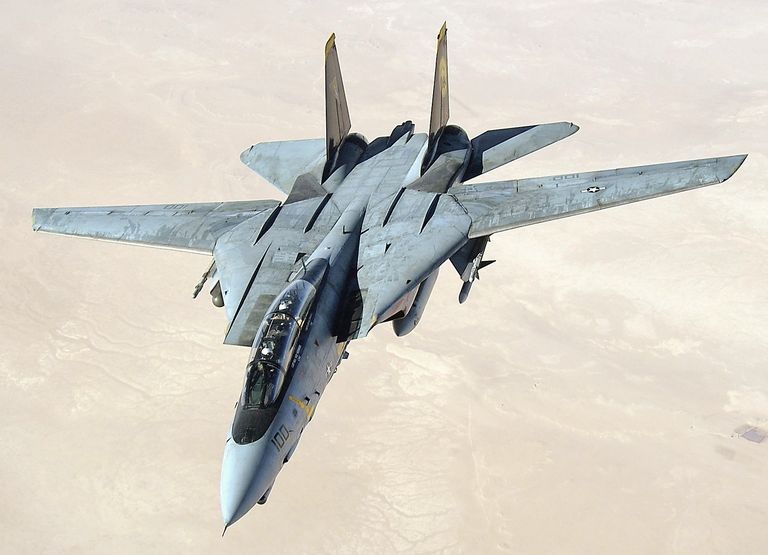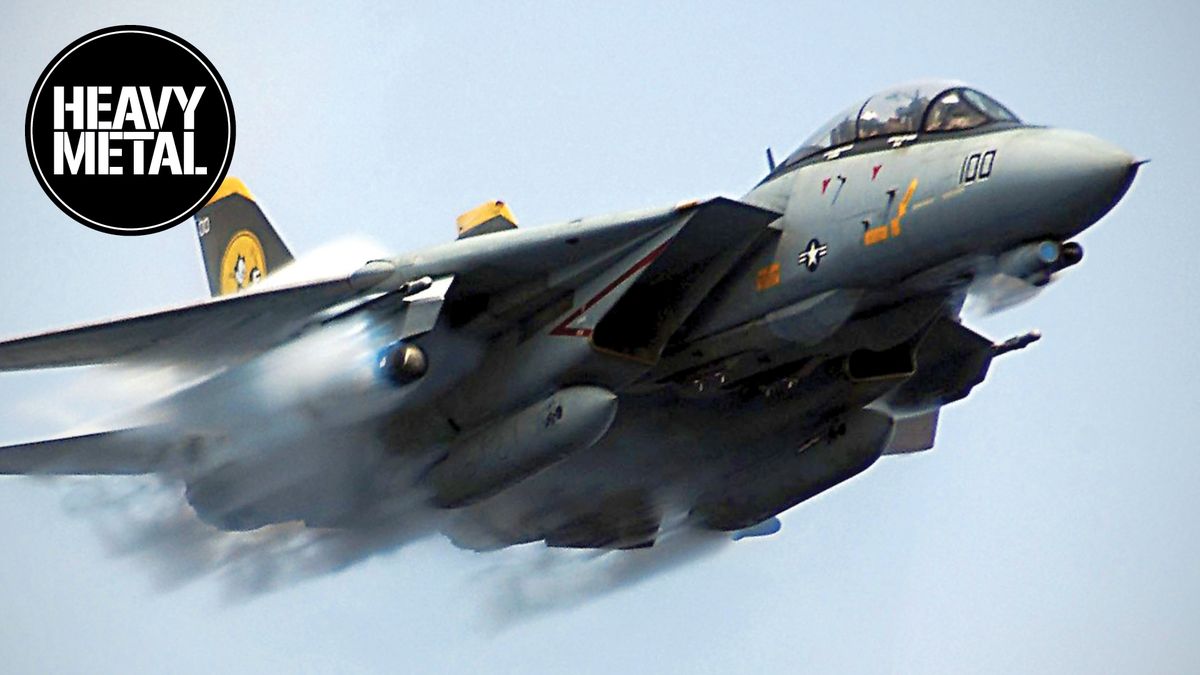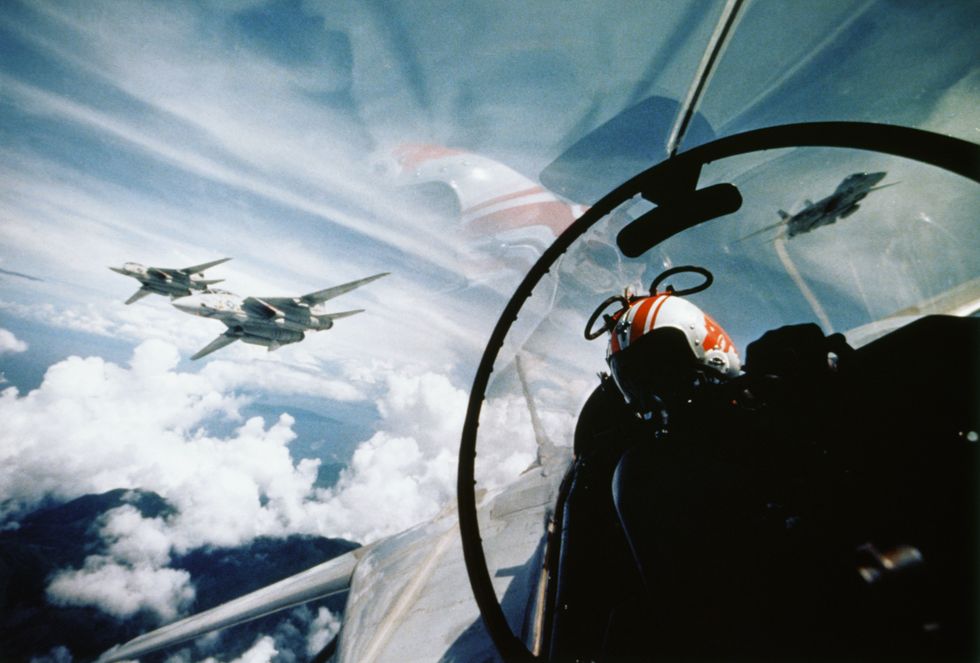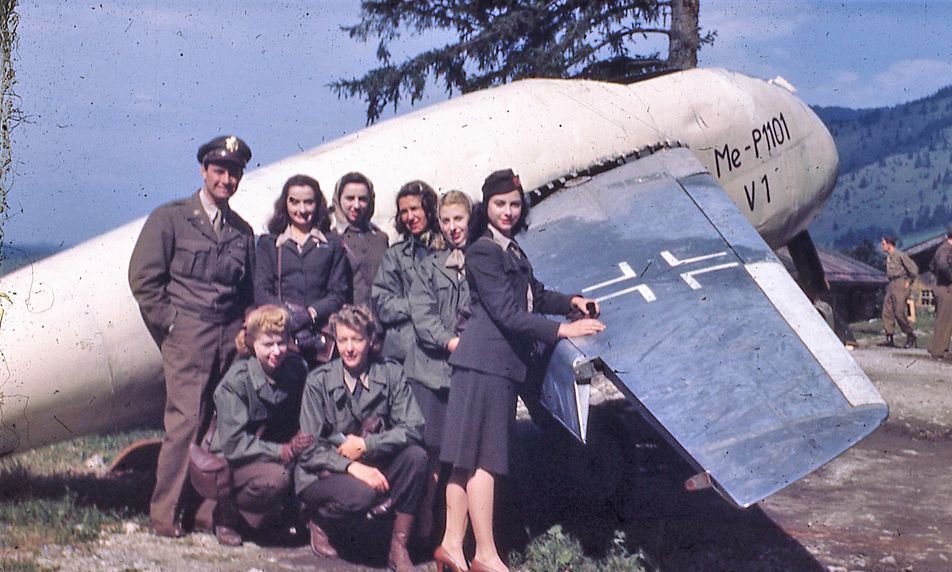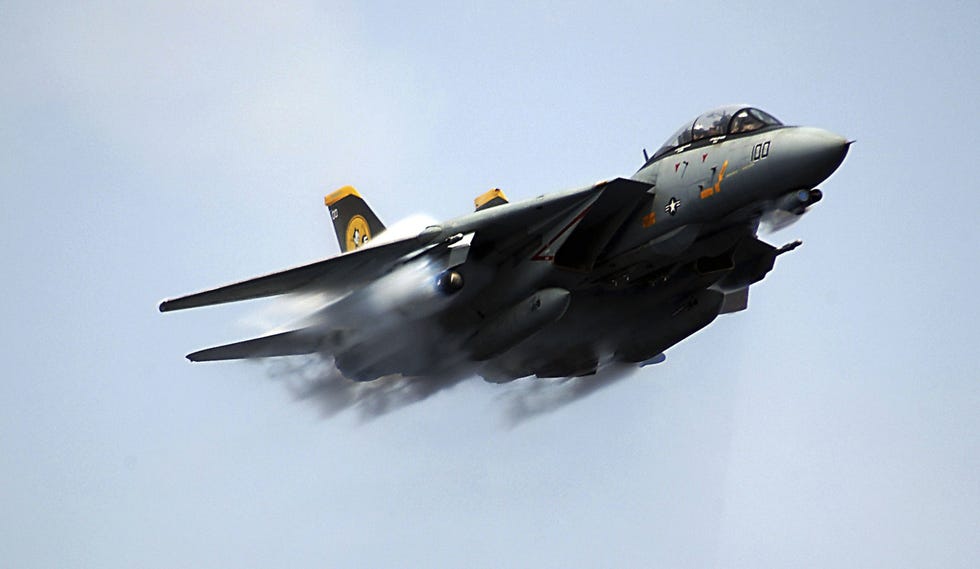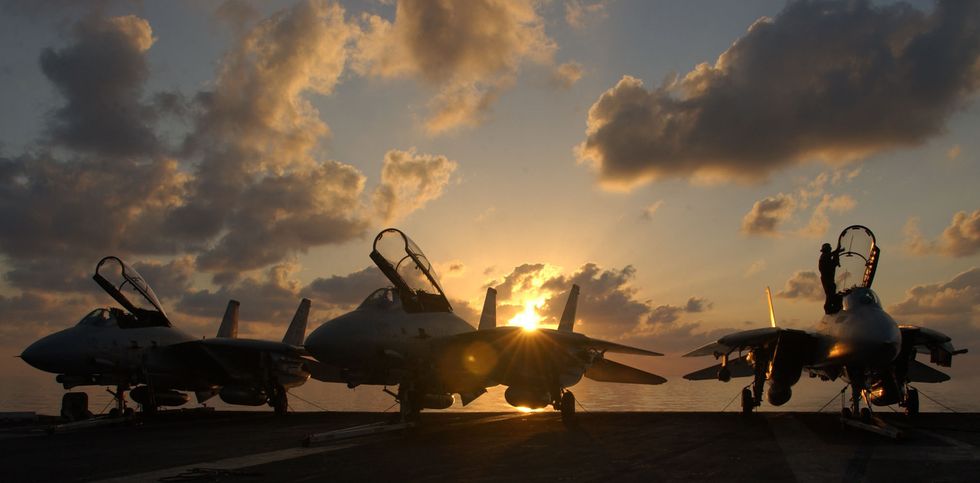August 1981 opened with a massive show of American force in the Mediterranean Sea, just north of Libya. Two of America’s supercarriers, the USS Forrestal and the class namesake, USS Nimitz, had entered into what Libyan leader Muammar Gaddafi had illegally declared his nation’s territorial waters.
America’s carriers were there to oppose that declaration, and for days, fighters from both countries danced in an airborne extension of diplomatic tensions until two U.S. fighters entered into a deadly dogfight.
“The left side of the lead Libyan aircraft lit up with a big flame as the missile motor ignited,” recounted Lieutenant Larry “Music” Muczynski, one of the two F-14 Tomcat pilots. That missile banked up, missing both planes and giving the American fighters all the impetus they needed to see what the Navy’s newest air superiority fighter could do.
“He fired an AIM-9L off of station 1A (left glove pylon, shoulder station),” Music said of his fellow airman’s first shot. “The missile pulled lead, then did a ninety degree reversal and hit the aircraft in the tail. The aircraft started to roll, the drag chute deployed and the guy immediately ejected.”
And just like that, the Navy’s carrier-based bomber hunter, the F-14 Tomcat, had scored its first air-to-air victory, a plane built to defend America’s carriers from attacking aircraft in a massive global conflict that never came.
A Fighter Built to Hunt Bombers
America’s fleet of aircraft carriers has long served as the nation’s best means of force projection, but their sheer size made defending them a challenge. World War II proved aircraft were a larger threat at sea than enemy ships, and Vietnam showcased the F-4 Phantom’s shortcomings when it came to dogfighting. The Navy also knew that if the Cold War ever turned hot, a brutal war of attrition would be waged in the skies.
The Navy needed an aircraft that could serve as a carrier strike group’s frontline of defense—closing with inbound bombers at high speed and engaging them from long-enough distances to keep their carriers safely out of harm’s way.
It was initially hoped that the TFX aircraft program could provide both the Navy and Air Force with the planes that they needed. But thanks to testimony provided by Navy Admiral Thomas “Tomcat” Connelly before Congress, the Navy was granted permission to pursue its own plans for a carrier-based fighter.
The Navy’s TOPGUN school was already hard at work churning out pilots with the know-how and capability to take on the Soviet Air Force, but the branch needed an aircraft that could couple the short takeoff and landing capabilities needed for a carrier-based fighter with the high top speed, payload capacity, and maneuverability of an intercept fighter.
One “heavy” fighter design proposed by Grumman Aerospace Corporation seemed to fit the bill. Like the TFX fighter it would replace, this new design would incorporate a sweeping variable-geometry wing design that would allow the aircraft to maximize lift during takeoff and minimize drag during high-speed flight.
The concept wasn’t entirely new. Shifting wings of this sort had appeared on aircraft dating back to Nazi Germany’s Messerschmitt P 1101, though that aircraft never actually flew. The prototype was discovered by American troops when they seized a Nazi research laboratory in the Bavarian Alps in 1945. The discovery left a particular impression on Robert J. Woods, the intelligence-gathering team’s commander. Woods would go on to co-found and serve as the chief designer for Bell Aircraft Corp.
During takeoff and low-speed flight, the wings on the new Grumman F-14 would shift forward at the tips, expanding their overall surface area and providing the fighter with greater lift. At supersonic speeds, however, those wings would tuck backward and minimize the surface area, making it a more efficient high-speed pursuit fighter and granting it a higher top speed and better fuel economy than its fixed-wing counterparts.
And when the Navy said “high speed,” they meant it. Their newly designed F-14 Tomcat (named in honor of its biggest advocate) would still put modern heavyweights like the F-35 Joint Strike Fighter and F-22 Raptor to shame.
“The [Navy] specs called for Mach 2.34,” said Charlie Brown, a member of the F-14 design team and Grumman test pilot. “We actually tested the airplane for Mach 2.5. I flew it 2.5 a couple times. When you fly a Phantom, it’s built for 2.0, but when you fly that fast, you know it. It’s like sitting on a beach ball; you don’t know which way it’ll go, it’s so sensitive. In a F-14, it’s like sitting in a Cadillac.”
The Navy liked its new fighter so much that it opted to skip the prototype phase altogether, putting the fighter into production in 1969 and taking delivery of its first new F-14s in 1972.
Production continued until 1991, with a total of 712 F-14s built.
Air Superiority, No Compromises
At just shy of 63 feet long and boasting a 64-foot wingspan, the F-14 Tomcat could attain speeds in excess of Mach 1 at sea level and surpass Mach 2.34 at altitude thanks to two General Electric F110-GE-400 afterburning turbofan engines that each produced more than 28,000 pounds of thrust with their afterburners engaged. All told, the F-14 could cover 1,600 miles without refueling, but was generally considered to have a 1,000-mile combat range.
The F-14 was fast—there’s no doubt about it. And while its sweeping wing system, which adjusted automatically for optimal performance at any speed or altitude, made the big, heavy fighter surprisingly nimble, there was more to the F-14 than fancy wings. New technology buried deep within the fighter’s eye-catching exterior made the F-14 a truly formidable opponent.
From the radar-intercept officer’s seat, located just behind the pilot, you could track as many as 24 enemy aircraft from as far away as 195 miles with the AWG-9 X-band pulse-doppler radar, which just so happened to utilize one of the first microprocessors to ever find its way onto a fighter jet. The powerful onboard systems could even direct long-range missiles to six separate targets simultaneously without losing track of the others.
“The Tomcat/AUG-9 radar/Phoenix trio were conceived to protect the fleet from supersonic Soviet bombers whose only goal was destruction of the carrier,” Paco Chierici, former F-14 pilot and author of Lions of the Sky, tells Popular Mechanics.
The AWG-9 system was so capable that the F-14 could even target and engage airborne cruise missiles. That system was initially bolstered by the Western world’s only internal Infrared Search and Track sensor at the time, the ALR-23—though that system was eventually replaced with an optical sensor that fed data directly into the AWG-9.
The fighter’s armaments were equally robust, with a variety of options to choose from based on the type of target and its distance from the Tomcat. With ten total hardpoints and a weapons payload capacity of 14,500 pounds, the Tomcat packed a serious punch, but the real heavy-hitter was the Phoenix missile.
“The Tomcat was a massive airplane wrapped behind an enormous radar specially built to fire the most lethal air-to-air missile in the western inventory, the AIM-54 Phoenix,” Chierici explains. “Missiles fielded today are just catching up to some, but not all, of the capabilities the Phoenix possessed.”
Gone the Way of the Cold War
After the fall of the Soviet Union in 1991, the U.S. Navy found itself at a crossroads. Without the looming spectre of Russian bombers to contend with, the powerful F-14 became a warrior without a war.
Sixty-five F-14s were upgraded to use Tactical Airborne Reconnaissance Pod Systems (TARPS), making the dogfighting platform a highly capable reconnaissance aircraft, and others were refit to make them more suitable air-to-ground strike platforms. But the finicky F-14 was costly to maintain and more difficult to operate than some newer fourth-generation competitors, like the F/A-18 Hornet and its own successor, the Super Hornet.
When the Gulf War kicked off, the F-14’s now-dated systems lacked the ability to discern between friendly and enemy aircraft from long distances, and thanks to the plane’s reputation as a dogfighting champ, Iraqi fighters made it a point to avoid engaging with them. The Tomcat found itself relegated to fruitless patrols. Worse still, the Navy lost one Tomcat to an Iraqi SA-2 surface-to-air missile.
Thanks to some electronics upgrades, Tomcats flew air strike missions against ground targets in the early days of the modern wars in both Iraq and Afghanistan, but the glory days of the Tomcat were already behind it.
The less-expensive Super Hornets were purposely built with air-to-ground engagements in mind, and as the old millennium gave way to the new one, the Navy began to feel like keeping a fleet of air superiority fighters on its carriers was less important and too expensive.
In 2006, the F-14 was retired in favor of the slower, cheaper Super Hornet.
From Top Gun to Bottom Rung
In 1986, 20 years before the Tomcat’s retirement, Top Gun dominated the box office, but the success of the film did far more than just fill up American movie theaters. Navy recruitment boomed as recruiters set up tables right outside of screenings to field questions from aspiring aviators. Tom Cruise may have been the star, but for young Americans with dreams of flying a fighter jet, it was the Tomcat that truly stole the show.
Now the U.S. Navy has fed most of its remaining F-14s into massive industrial shredders—a tragic end for such an iconic aircraft. Prior to the Iranian revolution in the late 70s, the U.S. sold Iran 79 Tomcats. Today, fewer than 12 are believed to be operational with fears that any remaining parts find their way into Iranian hands.
But the aircraft’s legacy lives on (and not just in Top Gun: Maverick).
Systems pioneered on the Tomcat continued to mature and can now be found on numerous fighter platforms. And with a rising China, it seems likely that elements of the Tomcat will find life once again in the form of America’s forthcoming air superiority fighter, currently called the “PCA,” for “Penetrating Counter Air.”
The F-14 was a fighter purposely built for a war that never was. But when deterrence is the name of the game, the Tomcat accomplished its mission. After all, it’s tough to beat a fully loaded F-14 screaming your way at twice the speed of sound, strapped with more than 14,000 pounds of missiles.
Alex Hollings is the editor of the Sandboxx blog and a former U.S. Marine that writes about defense policy and technology. He lives with his wife and daughter in Georgia.
